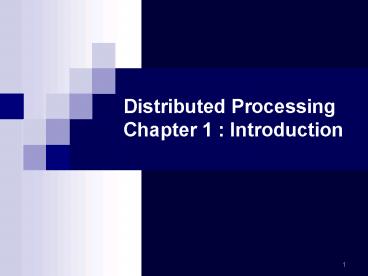Distributed Processing Chapter 1 : Introduction - PowerPoint PPT Presentation
1 / 25
Title:
Distributed Processing Chapter 1 : Introduction
Description:
Pusan National University. STEM-PNU. Problem. There are n nodes, each of which has a value. ... Pusan National University. STEM-PNU ... – PowerPoint PPT presentation
Number of Views:46
Avg rating:3.0/5.0
Title: Distributed Processing Chapter 1 : Introduction
1
Distributed ProcessingChapter 1 Introduction
2
Problem
- There are n nodes, each of which has a value. A
node wants to know the maximum value among the n
nodes. - Centralized Approach
- A server maintains the values of n nodes and each
node reports its value to the server. - Then the query node sends a message to ask the
maximum value to the server, which will answer to
the query. - Distributed Approach
- Each node communicates with its 6 nearest
neighbor nodes to inform its value. - Then the query node eventually finds the maximum
value by exchanging information with its neighbor
nodes.
3
Discussion
- Question 1 Find the algorithm for distributed
approach. - Question 2 Compare the performance
- In terms of the number of communications
- Question 3 Make a comparison table for the two
approaches
4
Definition of a Distributed System
- Distributed system
- 1) A collection of (scalability)
- 2) independent computers that (heterogeneity)
- 3) appears to its users as a single coherent
system (transparency) - Distributed System versus Parallel System
- Separated Operating System vs. Single Operating
System - Message Passing vs. Shared Memory
5
Why Distributed System ?
- Performance
- Incremental Growth (Scalability)
- 1 single mainframe of price W
- N small machines of price W/N
- Fault Tolerance
- 1 single mainframe critical weak point
- Failure of a machine replacement by other
machines - Geographical Distribution and Availability
- Flexible configuration
- e.g. 1 Disk server, 3 Computing servers, 1
Graphic server, etc. - Geographical availability
6
Distributed System - Scalibility and
Heterogeneity
1.1
A distributed system organized as middleware. ?
Heterogeneity and Scalability
7
Distributed System - Transparency
Different forms of transparency in a distributed
system.
8
Distributed System Heterogeneity
Application Program or Client
Client has to be provided with one different
driver for each server
9
Distributed System Heterogeneity and
Object-Oriented Approach
Application Program or Client
Predefined interface
Wrapping with predefined interface
Encapsulation Object-Oriented Approach
10
Hardware Concepts Multiprocessor
1.6
11
Multiprocessors (1)
- A bus-based multiprocessor.
1.7
12
Multiprocessors (2)
- (a) A crossbar switch
- (b) An omega switching network
1.8
13
Homogeneous Multicomputer Systems
- (a) Grid
- (b) Hypercube
14
Software Concepts
- An overview of
- DOS (Distributed Operating Systems)
- NOS (Network Operating Systems)
- Middleware
15
Issues in System Design
- Transparency
- Flexibility
- Reliability
- Performance
- Scalability
- Interoperability
16
Transparency
- Hiding physical details about
- Location
- Migration
- Duplication
- Relocation
- Concurrency
- Parallelism
- Location
- Access
17
Flexibility
- Should be easy to modify functionality and
architecture - To provide with Configurability, Avalability and
Autonomy - Micro-Kernel vs. Monolithic Kernel
- Monolithic Kernel Provides all functionalities
of OS. example. UNIX - Micro-Kernel
- Minimal subset of OS what users want
- Example
- Kernel Watch
18
Reliability
- Important Goal of Distributed System
- Reliability
- Security
- Fault-Tolerance
- Failure Probability P
- Should be P P1P2P3 Pn
- But often P P1 P2 P3 Pn in reality
19
Performance and Scalability
- Improve performance by parallelism
- Throughput T
- Ideally should be T Tn when n is the number of
sites - In reality T lt Tn
- Due to some Bottleneck
Throughput
Number of sites
??
20
Granularity of Parallelism
- Unit of Task
- Fine-Granularity vs. Coarse Granularity
- Fine-Granularity
- Large number of small tasks
- Need a large amount of inter-task communication
- Not good for distributed system (good for
Parallel system) - Coarse-Granularity
- Small number of big tasks
- Only small amount of inter-task communication
- Good for distributed system
21
Interoperability
- Easy to collaborate with other systems in
run-time - Compatibility, Portability
- How to achieve Interoperability
- Well-Defined API set
- Standardization
22
Hardware Concepts Multiprocessor
1.6
23
Multiprocessors (1)
- A bus-based multiprocessor.
1.7
24
Multiprocessors (2)
- (a) A crossbar switch
- (b) An omega switching network
1.8
25
Homogeneous Multicomputer Systems
- (a) Grid
- (b) Hypercube































